Summer cropping options to manage root lesion nematodes
Author: Kirsty Owen, Tim Clewett and John Thompson, University of Southern Queensland | Date: 21 Jul 2016
Take home messages
- Test soil for nematodes and plan crop rotations that target the correct nematode species identified.
- Mungbean cultivars are susceptible to P. thornei.
- Sorghum hybrids are susceptible to P. neglectus.
- Maize hybrids range from susceptible to moderately resistant to P. thornei.
- Soybean cultivars are highly susceptible to P. thornei.
- When root-lesion nematode populations are detected in large populations, avoid growing susceptible crops.
- Resistant crops will reduce high root-lesion nematodes but several consecutive resistant crops and fallow may be needed to reduce very high populations.
- Tolerant crops can produce good yields when root-lesion nematodes are present but you need to select tolerant varieties with high levels of resistance to have the biggest impact.
Current status of root-lesion nematodes in the northern grain region
Management of the root-lesion nematodes, Pratylenchus thornei and P. neglectus starts with knowing the populations you have present in your paddocks. PreDictaB (South Australian Research and Development Institute (SARDI)) offers soil tests for both species of root-lesion nematodes. Their website for contact details is: http://pir.sa.gov.au/research/services/molecular_diagnostics/predicta_b (or search for PreDictaB).
Maps of the distribution of P. thornei and P. neglectus from samples submitted to PreDictaB are available on-line and reproduced in this paper (Figure 1a and b). Results from autumn 2015 show that in the northern grain region, Pratylenchus thornei is more widely distributed and found in greater, more damaging populations than P. neglectus. In the northern region, paddocks with more than 15 P. thornei/g soil (or 15,000/kg soil) by the PreDictaB test are classified as high risk for crops. However, in the northern region, even populations of P. thornei are classified as medium risk by PreDictaB, that is 2–15/g soil (or 2,000–15,000/kg) soil can cause substantial yield loss of intolerant wheat varieties in warm wet growing seasons conducive to nematode reproduction in the roots. Therefore 2 nematodes/g soil (or 2,000/kg soil) should be regarded as the threshold for loss in intolerant crop cultivars.
a)
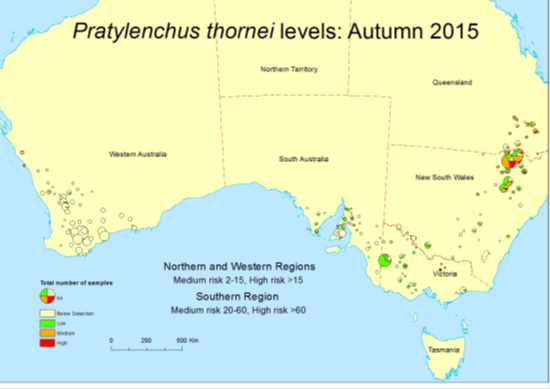
b)
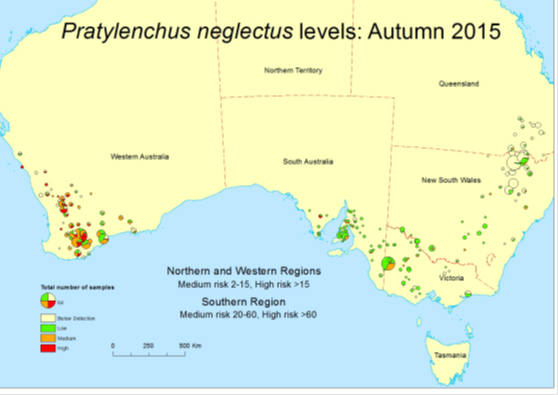
Figure 1. The distribution and risk of causing yield loss of samples submitted to PreDictaB, SARDI in autumn 2015 for a) Pratylenchus thornei and b) P. neglectus. Maps are reproduced with permission from http://pir.sa.gov.au/research/services/molecular_diagnostics/predicta_b
Once you know which root-lesion nematode species is present in your paddock and the population size, you can plan your crop rotations to 1) select tolerant varieties so that yields are maximised and 2) reduce the size of the populations by growing resistant crops. Tolerance is the impact of root-lesion nematodes on plant yield and resistance is the ability of the nematode to reproduce on the plant. Each species of root-lesion nematode has a unique and broad host range including cereals and legumes (Table 1). A summary of the host range of P. thornei and P. neglectus is available in the article ‘2015 Root-lesion nematodes Northern Region, GRDC Tips and Tactics’. Download a copy at the GRDC website (or search for root lesion nematodes northern grain region Tips and Tactics).
GRDC Factsheet on Root Lesion Nematodes (2015)
Table 1. Comparison of the risk of build-up of Pratylenchus thornei and P. neglectus for crops (from Tips and Tactics, Root-lesion nematodes Northern Region, GRDC 2015)
|
Crop |
P. thornei |
P. neglectus |
|
|
Cereals |
|||
|
Barley |
Medium to high |
Low to medium |
|
|
Canary seed |
Low |
Low |
|
|
Maize |
Low |
Low |
|
|
Millet |
Low |
Low |
|
|
Oats |
Low |
NT |
|
|
Sorghum (grain) |
Low |
Medium to high |
|
|
Triticale |
Medium to high |
Low |
|
|
Wheat |
Low, medium to high |
Low, medium to high |
|
|
Legumes |
|||
|
Blackgram |
High |
Medium (p) |
|
|
Chickpeas |
Medium to high |
Low to medium |
|
|
Cowpeas |
High |
NT |
|
|
Faba beans |
Medium to high |
Low |
|
|
Field peas |
Low to medium |
NT |
|
|
Navy beans |
High |
NT |
|
|
Mungbeans |
Medium to high |
Low |
|
|
Pigeon peas |
Low |
NT |
|
|
Oilseeds |
|||
|
Canola, mustard |
Low to medium |
Medium to high |
|
|
Cotton |
Low |
Low |
|
|
Linseed |
Low |
Low |
|
|
Soybeans |
High |
Low |
|
|
Sunflowers |
Low |
Low |
|
|
Pastures, forage |
|||
|
Brassica (forage) |
Low to medium (p) |
NT |
|
|
Lablab |
Low |
NT |
|
|
Sorghum (forage) |
Low |
Medium to high |
|
Within some crops there is variation in the susceptibility and resistance of varieties, and this is indicated where a range of risk ratings is shown. New varieties or hybrids may differ in their risk ratings from the overall rating for a crop species. NT, Not tested; p, provisional rating.
Our previous field experiments with summer crops have demonstrated that crops such as sorghum and millet are moderately resistant to P. thornei and crops such as soybean and mungbean are susceptible (Figure 2). However, one moderately resistant crop in a sequence is not enough to reduce damaging populations of P. thornei. Two or more resistant crops grown consecutively are needed to get on top of root-lesion nematodes. Figure 3 shows populations of P. thornei increased after growing most cultivars of mungbean and soybean compared to fallow and sorghum hybrids.
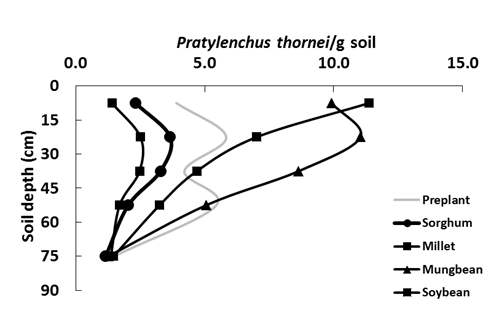
Figure 2. Compared to the populations of P. thornei at planting (grey line) sorghum and millet caused populations to decrease throughout the soil profile, however mungbean and soybean caused populations to increase markedly.
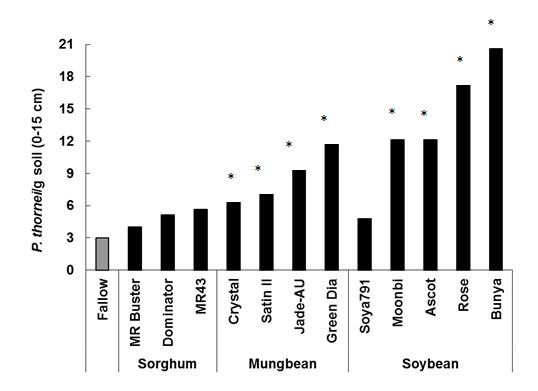
Figure 3. After harvest of the summer crops, Pratylenchus thornei was found in highest populations following mungbean and soybean cultivars. * indicates significantly larger P. thornei populations than the fallow treatment (P<0.05). Green Dia is mungbean cv. Green Diamond.
All varieties listed are protected under the Plant Breeders Rights Act 1994.
New Results
Mungbeans and P. thornei
Mungbeans are susceptible to P. thornei but are poor hosts of P. neglectus. New results from a field experiment showed when P. thornei populations started, on average, at 6 P. thornei/g soil, nematode populations increased to 12 to 39 P thornei/g soil. The change in P. thornei populations for each cultivar is shown as the reproduction factor in Figure 4. P. thornei increased between 2 and 2.7 times after growing mungbean cultivars and up to 8.5 times after growing blackgram cv. Regur (Figure 4). Our previous field trials have not detected any yield loss in mungbeans due to P. thornei indicating that they are tolerant. The take home message for mungbeans is to be aware that they will cause P. thornei to increase and should not be included in rotations where you are trying to reduce populations of P. thornei.

Figure 4. Mungbean and blackgram cultivars are susceptible to the root-lesion nematode, Pratylenchus thornei. Plants were grown in the field at Formartin on the Darling Downs, Queensland, with the average starting population of 6 P. thornei/g soil. Reproduction Factor = the final P. thornei population ÷ the initial P. thornei population. Soybean cv. Bunya was included as a susceptible control; Grn Diamond is mungbean cv. Green Diamond; Regur is a cultivar of blackgram.
All varieties listed are protected under the Plant Breeders Rights Act 1994.
Sorghum and P. neglectus
Sorghum is an excellent crop to include in rotations where P. thornei is present because it is moderately resistant. However, sorghum is susceptible to P. neglectus. Recently hybrids of sorghum were screened in glasshouse experiments for resistance to the root-lesion nematode, P. neglectus. New results show there are a range of responses for sorghum from susceptible to moderately susceptible (Figure 5). Our previous results have shown that forage sorghum hybrids are also susceptible to P. neglectus with the sweet sorghum hybrids being most susceptible and the grain sorghum x Sudan grass hybrids being moderately susceptible. Growing sorghum will cause populations of P. neglectus to increase and nematodes will remain in high numbers to attack the next crop. These results highlight the importance of testing soil for root-lesion nematodes to identify which species is present in your paddocks.
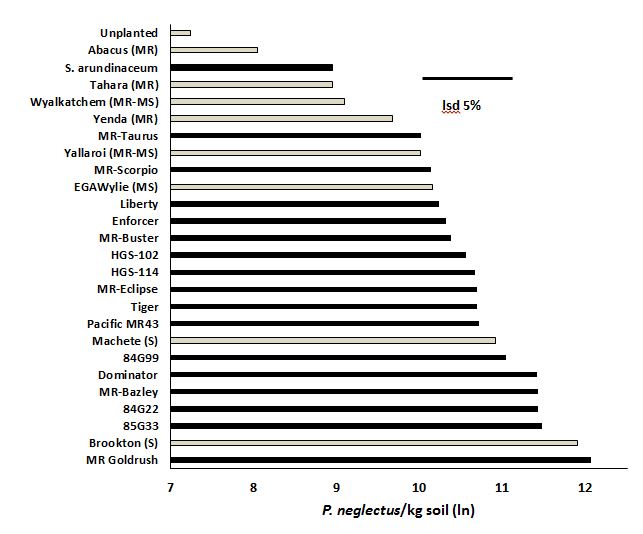
Figure 5. New data shows that sorghum hybrids range from susceptible to moderately susceptible to the root-lesion nematode, Pratylenchus neglectus. Plants were grown for 18 weeks in the glasshouse after inoculation. Grey bars indicate cereal and unplanted standards with known resistance/susceptibility to P. neglectus.
All varieties listed are protected under the Plant Breeders Rights Act 1994.
Maize and P. thornei
Recently hybrids of maize were screened in glasshouse experiments for resistance to the root-lesion nematode, P. thornei. New results show there are a range of responses to P. thornei for maize from susceptible to moderately resistant (Figure 6). Our previous field trials have not detected any yield loss in maize indicating that they are tolerant. Although maize may not suffer yield loss due to P. thornei, some hybrids of maize will cause populations of the nematode to build up and nematodes will remain in high numbers to attack the next crop.
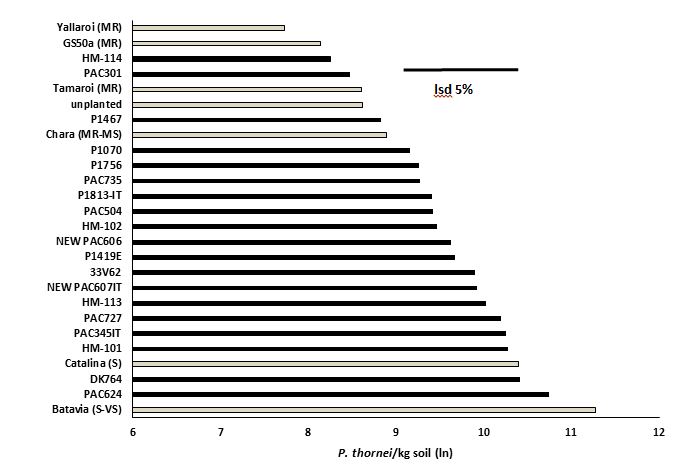
Figure 6. New data shows that maize hybrids range from susceptible to moderately resistant to the root-lesion nematode, Pratylenchus thornei. Plants were grown for 18 weeks in the glasshouse after inoculation. Grey bars indicate cereal and unplanted standards with known resistance/susceptibility to P. thornei.
All varieties listed are protected under the Plant Breeders Rights Act 1994.
Wheat and barley
Each year, new varieties and advanced lines of wheat varieties are tested as part of the National Variety Trials for tolerance (which is the impact of root-lesion nematodes on plant yield) and resistance (which is the ability of the nematode to reproduce on the plant). Barley varieties are tested for resistance to root-lesion nematodes. The results of repeated experiments from the field and glasshouse are shared nationally with other nematode researchers and a consensus rating of tolerance and resistance is produced. These results are available at the NVT website (http://www.nvtonline.com.au/)
How do you use this information to manage root-lesion nematodes?
When you have your soil test results, plan your crop rotations to reduce the root-lesion nematode populations. Rotations will differ depending on whether you have P. thornei, P. neglectus or both species. Very high nematode populations are reduced by increasing the number of resistant crops grown consecutively in rotations. It may take two or more resistant crops to reduce damaging populations. When root-lesion nematodes are present, tolerant crops will produce higher yields than intolerant crops. However not all tolerant crops are resistant. The NVT website lists ratings of tolerance and resistance for wheat and barley and the GRDC Tips and Tactics factsheets are available for information on other crops. Keep an eye on how root-lesion nematode populations change during rotations and consider testing soil again in 3-5 years. You can’t eliminate root-lesion nematodes from soils, but with careful planning you can minimise their impact on your farm profits.
Acknowledgements
The research undertaken as part of this project is made possible by the significant contributions of growers through both trial cooperation and the support of the GRDC; the authors would like to thank them for their continued support.
We would also like to thank PreDictaB at SARDI, for providing the distribution maps; the Gywnne family for the use of their land for our experiments; Kerry Bell, DAFQ, for design and analysis of experimental data.
Contact details
Kirsty Owen
Centre for Crop Health, University of Southern Queensland
Leslie Research Centre, PO box 2282, Toowoomba, 4350 QLD
Ph: 07 46 311 239
Email: Kirsty.Owen@usq.edu.au
GRDC Project Code: DAV00128,
Was this page helpful?
YOUR FEEDBACK
